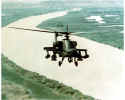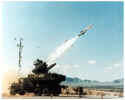1988
FY 88 For the first time ever, MICOM attained a percentage of African-American workers equal to the percentage of African Americans in the civilian work force of the Huntsville, Alabama, area.
FY 88 A significant new mission at Redstone Arsenal involved support to the Intermediate Range Nuclear Forces (INF) Treaty. The MICOM Safety Office became integrally involved in planning and preparing for the safe conduct of INF inspections of the installation by representatives of the Soviet Union. These procedures became the baseline for all CONUS inspection sites. The INF On-site Inspection (OSI) mission also influenced every aspect of the Intelligence and Security Directorate's (ISD's) activities. The organization's director was appointed Special Assistant to the MICOM Commander for INF OSI matters, while the directorate became the command focal point for the new INF mission.
FY 88 The Logistics Assistance Division of the Missile Systems Readiness Directorate implemented the Army Reserve Individual Mobilization Augmentee (IMA) program to provide the best source of trained wartime manpower in the event of mobilization. The IMAs would be pre-trained; able to report for duty without delay, orientation, or need for further training; and prepared to professionally execute their assigned duties.
FY 88 PAD laid the groundwork for implementing the new DOD total quality management (TQM) initiative. The goal of this new program was to improve the quality of DOD products and services while achieving substantial reductions in the cost of ownership throughout the life cycle of weapon systems. The program would broaden the concept of quality by focusing on the issue much earlier in the system acquisition process.
FY 88 During the first quarter, the first USAREUR unit to be fielded with the HELLFIRE - the 2/6th Attack Helicopter Battalion-participated in the Return of Forces to Germany (REFORGER) 88 exercise.

January-November 88 A major renovation of the NCO Club was undertaken and completed in this period.
14 January 88 The International Cooperative Program (ICP) Office was established to manage the MICOM RSI program previously handled by SAMD.
14 January 88 The SHORADS building within OMMCS was renamed Barclay Hall in honor of the late MG John A. Barclay, former DCG of the U.S. Army Ordnance Missile Command (AOMC). A pioneer in the Army's early missile and space programs, Barclay's work led to the development of the first computer and the procurement of the Army's first missile systems. The ceremony on this date marked the first building dedication within the OMMCS campus in more than 20 years, the last being Toftoy Hall in November 67.
29 January 88 The first TOW 2 WCL missile was fired at MICOM Test Area I.
February 88 Remains of 59 burials uncovered this month from an unmarked and unrecorded cemetery in the I-565 right of way near Redstone Arsenal's Gate 9 were later reburied on the installation following a historical examination to determine who was buried there and when. The 2-acre cemetery was located partly on the arsenal and partly on a right of way ceded by the Army to the State of Alabama. The section of the cemetery that was within Redstone Arsenal contained about 150 graves.
Read the special section on the Elko Switch Cemetary.
February 88 To offset the loss of $250,000 when Congress passed a law calling for revenue-generating activities to be self-supporting, the Redstone Arsenal Golf Course expanded the hours eligible civilians could play.
25 February 88 The Swiss MOU for coproduction of the STINGER-RMP (less reprogrammable module) was signed.
March 88 The quality factor in productivity excellence was given new impetus when the Secretary of Defense launched the TQM concept as a vehicle for attaining continuous quality improvements in DOD operations. TQM was both a strategy and a philosophy, the aim of which was the continuous improvement of products and services.
March 88 The 1st Attack Helicopter Battalion, 6th CAV, III Corps was the first operational unit to fire HELLFIRE missiles.
7 March 88 Anti-nuclear protestors gathered outside Redstone Arsenal's Gate 1. The group of about 40 people, calling themselves the Southern Connection Caravan, were enroute to Nevada to protest underground nuclear testing, but they stopped periodically to stage protests against nuclear tests in general. The group demonstrated on Martin Road in order to "raise the consciousness of morality and environmental effects of weapons, especially nuclear, in space."
5 April 88 HAWK demonstrated its capability to receive and use PATRIOT acquisition data to engage a short-range ballistic missile. A PATRIOT test target programmed to fly a trajectory characteristic of a Soviet short-range TBM was intercepted and destroyed at WSMR. To add the ATM capability to the HAWK on a permanent basis, an effort requiring primarily software changes was under way.
26 April 88 The consortium MOU for the European production of the STINGER weapon system was signed by all the member nations, subject to ratification by their respective parliaments. The MOU was ratified by Germany, the Netherlands, and Turkey before year's end.
30 April 88 Despite the success of the initial test firings of the TOW 2 WCL guidance system missiles, the contract for this effort expired due to insufficient funding for additional testing.
31 May 88 MLC's Replenishment Part Purchase or Borrow (RPPOB) Program showroom officially opened. Part of the DOD Replenishment Parts Breakout Program, the RPPOB effort was designed to reduce costs by increasing the number of potential sources for spare parts. It not only promoted competition but established alternative sources of supply.
31 May 88 The contract for the improved HELLFIRE warhead was awarded to Rockwell International Corporation. The new warhead would enhance the HELLFIRE missile in its antiarmor role.
1 June 88 Raytheon delivered the 2000th PATRIOT missile to the Army.
June 88 to September 89 MG August M. Cianciolo served as MICOM Commander during this period. Unlike MG John B. Medaris or BG Barclay, though, Cianciolo earned his pilot's wings before he was assigned to Redstone Arsenal.

July 88 A unit of the Oklahoma National Guard became the first National Guard unit to receive the MLRS system.
July 88 The second post deployment build (PDB-2) software was successfully fielded, resulting in the deployment of PATRIOT ATM Capability One (PAC-1) and PATRIOT/HAWK Phase-1 interoperability capabilities.
July 16-17 The first Soviet inspectors visited Redstone Arsenal under provisions of the INF
July 88 Treaty. Their visit was part of the verification procedure on which the treaty between the United States and the Soviet Union rested.
17 July 88 AMC agreed to the disposal of all NIKE HERCULES secondary items, except those reserved for stockpile reliability flight testing at McGregor Range, New Mexico.
September 88 The MICOM target seeker and measurement facility, a 300-foot tower on the southeast end of Redstone Arsenal, opened this month.
September 88 LTVAD was awarded a full-scale development (FSD) cost-plus-incentive-fee contract for the MLRS BCW program.
September 88 The first fielding of the Bradley A1 vehicles with TOW 2 subsystems was completed.
15 September 88 The four original PEOs at Redstone Arsenal were merged into two as part of an overall realignment of the Army PEO structure directed by the AAE. The FAAD and HIMAD PEOs were united into the PEO Air Defense, while the Fire Support and Close Combat Missiles PEOs were combined in the PEO Fire Support.
26 September 88 MICOM took action to respond to a Secretary of Defense decision to remove the U.S. ROLAND system from the Army's inventory by the end of FY 88. He also wanted the system's management office to be abolished. Consequently, a small cadre was reassigned to the Fire Support SMO to complete the deactivation and disposition of assets. The cadre became operational on this date.
30 September 88 The U.S. Roland system was terminated. The contractors, vendors, and the New Mexico National Guard turned in all ROLAND assets, which were placed in temporary storage at McGregor Range, New Mexico.

30 September 88 LTVAD received a cost-plus-incentive-fee FSD contract for the MLRS SADARM program.
October 88 The Secretary of Defense announced that DOD would formally implement TQM throughout all its activities to achieve the highest possible quality at the lowest possible cost.
20 October 88 The MICOM Commander signed MICOM Regulation 1-36, implementing TQM as a strategy for continuously improving performance through a continuous quality improvement process.
21 October 88 Redstone Arsenal held the ribbon-cutting ceremony for its new "all-in-one", 18,500-square-foot Youth Center (Building 3148). The $1.8 million construction project was the only youth activities center in the Army built entirely with locally generated non-appropriated fund (NAF) money, produced partly by the bowling alley, golf course, clubs, and package store. The new structure included a gymnasium, large game room, crafts and meetings rooms, a lounge and snack area, a locker room, show facilities, and sound modules for music lovers.
1 November 88 The rollout ceremony for the first two AVENGER fire units was conducted at the Huntsville Boeing Aerospace facility. During fiscal year 1989, DA formally approved a name change from Pedestal Mounted STINGER to AVENGER.
December 88 Production of the PATRIOT ATM Capability Two (PAC-2), a missile upgrade that increased the PATRIOT's kill capability to catastrophic kill, was authorized
Redstone Arsenal Era:
Intro,
1980,
1981,
1982,
1983,
1984,
1985,
1986,
1987,
1988,
1989
